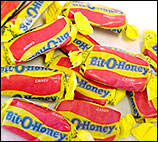A few weeks ago, I found Agave nectar in my local Walmart. I was stoked! It contains NO high fructose corn syrup (HFCS) and is actually a "natural" sweetener. Days later, I presented my find to our dear friends Dave & Rachel along with a joyful exclamation concerning the lack of HFCS. Dave responded frankly with, "What's so bad about high fructose corn syrup?"
The truth was: I had no idea what's so bad about HFCS. My aversion to it was constructed from vague impressions likely based on some episode of Oprah; or, more probably, a suspicion built on manufacturers' claims of "No high fructose corn syrup" on products I had seen in the grocery store. Surely it is bad for you if they are making such a fuss about it not being in their product, right?
So, for your benefit and mine, I set out this morning to discover answers to some of life's most pressing questions: What in the world is wrong with high fructose corn syrup, if anything? Is the claim "No HFCS!" that I find slapped all over foods--especially foods for kids--merely another term like "all natural" that helps manufacturers move products off the shelves, or is HFCS really something I should avoid at all costs?
Here is What I Found.
The big(gest) deal about HFCS seems to be the link between it and obesity in America; after all, the increased use of the substance in manufactured foods correlated with a record increase in obesity in the early 90's.
But the fact is that HFCS is made of half glucose and half fructose, which is the same as ordinary table sugar. This CBS News article I read refers to HFCS as "sugar with an image problem." In fact, recent research indicates that the two affect the body very similarly. According to Eating Well, Barry Popkin, one of the authors of the original study on HFCS that sent everyone into an uproar about its ill effects, confesses that singling out HFCS as the culprit was unjustified. Essentially, an increase in the use of any type of sugar would be strongly related to an increase in obesity. HFCS is simply cheaper (because of government subsidies on corn, mainly).
How much is enough? The folks over at the Mayo Clinic state women should consume only 6 teaspoons of ANY type of sugar (about 28.5 grams) per day, and men should consume only 9 (about 43 grams). To give you a frame of reference, one can of your average soda contains about 9 teaspoons of sugar. Yikes!
People who have eliminated HFCS from their diets do claim to feel less tired and often lose weight, which isn't surprising: Since HFCS is the sugar most commonly added to foods, it is logical that a drastic reduction/elimination of it would mean a reduction/elimination of the effects of sugar.
My conclusion:
I am by no means an expert, but what I have concluded--and this is really simplifying a lot of the information I read--is that we should not really be mad about HFCS being in so many foods on our grocery store shelves as much as we should be mad about any of the sugars that are unnecessarily added to so many of the foods we consume (concentrated fruit juice and raw sugar included).
Eating any kind of sugar in vast quantities is probably not very good for us, or our kids. While sugar does add flavor, it also adds calories to foods and drinks; consuming them results in "empty calories," or calories without any nutritional value. This can be a big problem for kids, whose growing bodies require nutrients to develop properly. Even if HFCS had no other ill effects on children (and there is research that shows it may), this should be reason enough to watch what we're letting our kids eat.
 |
| One of my favorite tooth-rotting treats as a child. |
Recipes this Week
- This one is actually from a few weeks ago. I was sick and asked Michael to "Please cook the salmon recipe" for dinner. He chose One Pot Salmon with Snap Peas and Rice, which was not actually the recipe I had in mind. I was, however, still very grateful because 1) he took excellent care of me, even though I'm pretty cantankerous when I'm sick; 2) he cooked some delicious food; and 3) he found this recipe that I had totally forgotten about! It is tasty, takes very little prep OR cook time, and everything cooks in the same pot. Win, win, win!
- This reminds me--I don't know if I've ever told you guys that we still eat fish from time to time. Well, we do. :)
- Today I made myself a Tex-Mex black bean sandwich for lunch, and it was delicious. Here's what I did:
- Lightly mash up however many black beans you want (I think I used about 1/3 cup for a half sandwich) and spread them onto the bread of your choice.
- Top the beans with Tex-Mex toppings. I used salsa, avocado, and a bit of shredded cheddar cheese. You could also use tomatoes, red onions, chiles, corn, and/or pickles.
- Serve with extra salsa and chips, and fresh fruit.


No comments:
Post a Comment